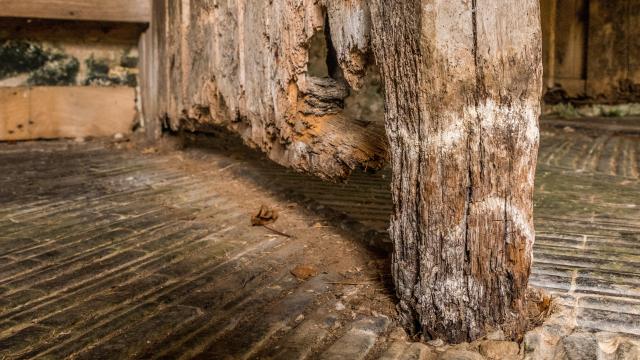If your home was constructed out of wood, its structural integrity depends on the natural material remaining intact and sturdy. So if you happen to notice that wood in your walls, floors, or support beams is losing its shape, changing colour, crumbling, or looks like it’s beginning to collapse, it’s important to take care of it as soon as possible.
But before you know what you need to do — or, in this case, what kind of professional you need to hire — you have to identify the problem. If you’ve spotted any of the conditions above, there’s a good chance you’re dealing with either wood rot or termite damage. But which one? Here’s how to tell them apart.
What is wood rot?
There are two types of wood rot — wet rot and dry rot — both caused by fungi. Wet rot is common in warm, damp areas, and tends to be visible from the outside. The fungi responsible for dry rot prefer temperatures between 65 and 90 degrees Fahrenheit, and destroy wood from the inside, while it appears dry on the outside.
What is termite damage?
Like the fungus that causes wet rot, most termites are drawn to warm, damp conditions, because they eat the cellulose in wood. Termites typically live in the soil around your house, and once they gain access through a crack or crevice in a wall or the foundation, they start chowing down on the wood inside your home. Like the fungus that causes dry rot, termites destroy wood from the inside out.
How to tell the difference between wood rot and termite damage
Despite what they have in common, there are a few key differences that will help you determine whether you’re dealing with wood rot or termite damage. These include:
Wood rot
- Wood feels soft or sponge-like
- Wood crumbles or turns to dust when pressure is applied
- Visible fungus or mould spores
- Swelling or discolouration of the wood
Termite damage
- Signs of actual termites (e.g. clicking sound inside walls, and dead winged insects inside the house)
- Wood sounds hollow when you tap or knock on it
- Small holes in interior woodwork or wooden furniture
- Maze-like tunnels on the inside of the wood
Once you know what you’re up against, you can seek out the help you need to address the problem before it gets worse.

Leave a Reply
You must be logged in to post a comment.